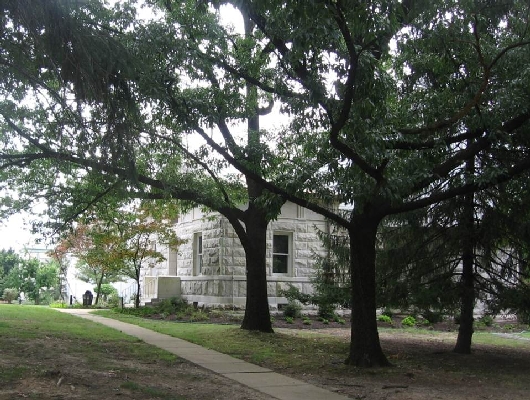The Washington Double Star Catalog

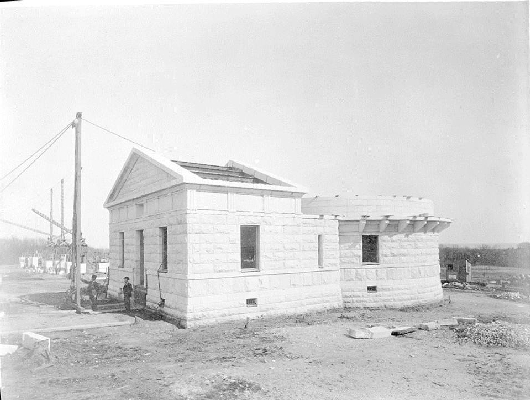
The debt to our ancestors for the observations they made our benefit,
we can pay only by doing the same to the advantage of our successors.
--- Ejnar Hertzsprung, 1961
(Click on Hertzsprung photo)
Introduction and Growth of the WDS
The Washington Double Star Catalog (WDS), maintained by the United States Naval Observatory, is the world's principal database of astrometric double and multiple star information. The WDS Catalog contains positions (J2000), discoverer designations, epochs, position angles, separations, magnitudes, spectral types, proper motions and when available, Durchmusterung numbers and notes for the components of 157263 systems based on 2230541 means. Of these, 37639 are physical, 9158 are optical, and 110466 are unknown. The current version is updated nightly. A brief summary and statistical analysis of the contents of the catalog are presented.
The Washington Visual Double Star Catalog (WDS) is the successor to the Index Catalogue of Visual Double Stars, 1961.0 (IDS; Jeffers, van den Bos & Greeby, 1963). Three earlier double star catalogs in this century, those by Burnham (BDS; 1906), Innes, Dawson & van den Bos (SDS; 1927), and Aitken & Doolittle (ADS; 1932), each covered only a portion of the sky. After more than a half-century of dedicated double star cataloging and observing, and after publication of the IDS, at a 1964 meeting of Commission 26 of the International Astronomical Union during the 12th General Assembly in Hamburg, Lick Observatory Director A.E. Whitford informed the Commission that Lick no longer wished the responsibility of maintaining the Catalog. An offer by Kai Strand, then early in his tenure as Scientific Director of the Naval Observatory, offered for the U.S. Naval Observatory to be the official Double Star Centre [sic]. This was voted on and approved by the Commission, and this meeting, 26 August 1964, is the inception date of the Washington Double Star Catalog.


Both the IDS and the WDS cover the entire sky, and the WDS is intended to contain all known visual double stars for which at least one differential measure has been published. The WDS is continually updated as published data become available. Prior to this, three major updates have been published (Worley & Douglass 1984, 1996, Mason et al. 2001, and 2006.5). The Washington Double Star Catalog (WDS) has seen numerous changes since the last major release of the catalog. The application of many techniques and considerable industry over the past few years has yielded significant gains in both the number of systems and the number of measures, as indicated below.
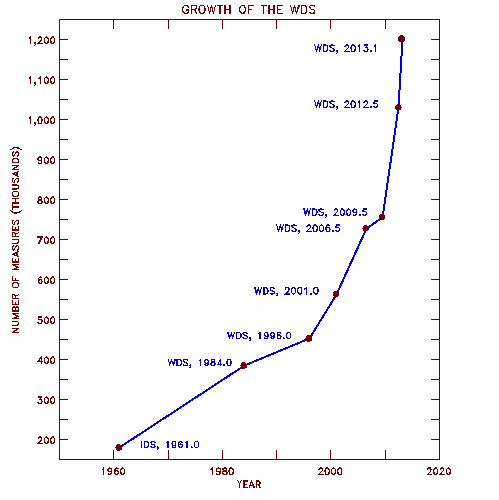
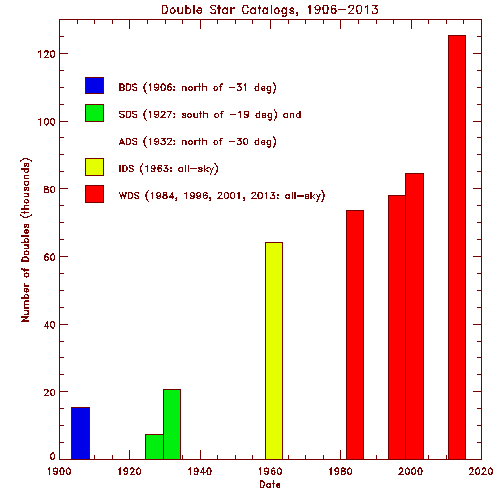
Figure 1, (left): Growth in the number of means in the WDS since its inception in the early 1960's. The 1984.0, 1996.0, 2001.0, and 2006.5 editions of the WDS are indicated as well as more recent dates. Figure 1, (right): Size of major double star catalogs and the WDS at specific dates as indicated.
The growth since the 2001.0 edition is due to many sources, however the most significant additions are:
- USNO matching of Two Mass (42,009)
- Tycho-2, both the TDSC and Tycho-2 matching done by USNO; 25,232)
- Washington Speckle Interferometry (7915)
- J.L. Comellas (double star measures from 1970-2003 published in OAG Catalog; 4725)
- T. Tobal (OAG Catalog & Supplements; 3987)
- D. Arnold (Double Star Observer and Journal of Double Star Observations series; 2694)
- E. Berko and collaborators (published in Webb Society Circulars; 1617)
- R. Harshaw (published in Webb Society Circulars; 1451)
- E. Horch et. al. (U. Mass Dartmouth, Speckle Interferometry; 1272)
- J. Greaves (common proper motion pairs; 1150)
While many thousand new systems have been added, many of these observing programs have resulted in a striking improvement in the number of observations per system, as shown below with a specific example of USNO speckle contributions. It is expected that with other large publications of data planned in the future such as the final release of the USNO CCD Astrograph Catalog the growth of the WDS will continue.
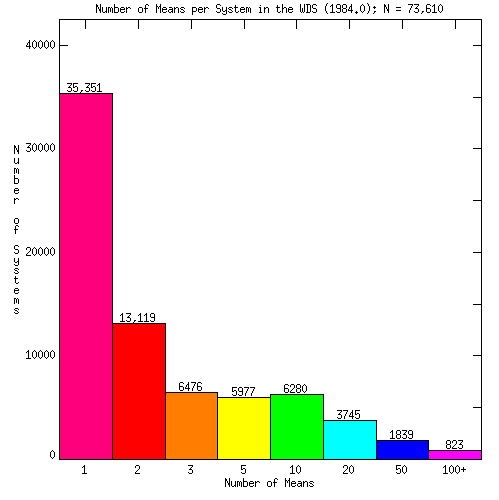

Figure 2: The number of means per system in the WDS, from left to right the 1984.0, 1996.0, 2001.5, 2006.5 major releases of the catalog and a "current status" (2013.0). Note that while the total number of systems has increased significantly, the number of measures per system is also steadily increasing.
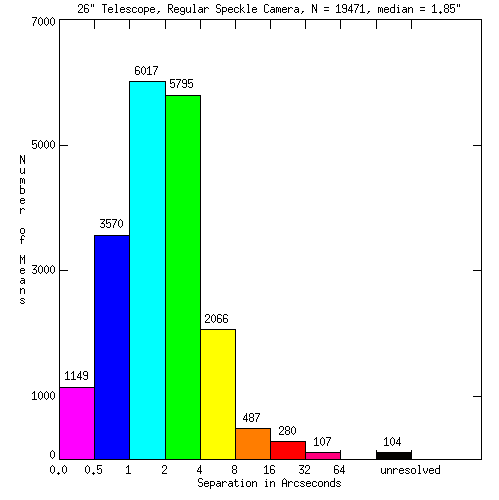

Figure 3: One source responsible for the increase in data is the prodigious publication of USNO speckle means. The three figures indicate all published USNO speckle data to 2013.0. At left is data obtained with the regular camera and the USNO 26", at middle is data obtained with the secondary (or backup camera) and the USNO 26" and the right is data obtained on other telescopes: the USNO Flagstaff Station 61", the McDonald 82", the Mt Wilson 100", and the two 4m telescopes of NOAO (KPNO & CTIO). Statistics are also provided. Note the variable margins in all figures for scaling.
A comparison of the contributions of the different techniques, both in their total number as well as mean and median separation are given here. Those techniques with no measures listed are unique to the Delta-m Catalog.
Primarily of historical interest, a list of the top 25 observers or distinct groups (based on the total number of measures and means) is presented here. The only observations included in this list are pointed observations for these specific doubles, not mined observations from published catalogs, an admittedly arbitrary qualification. In this table, numbers are based on the WDS reference code. Totals are provided for the number of means (usually, as published --- a line of data in the WDS measurement database, each mean position often comes from several measures, usually increasing their accuracy). The four active programs on this list are indicated and the first author for papers produced for the three groups are indicated as well.
Cross References
The cross-reference file has now been expanded and includes identifiers from the earlier Burnham Double Star (BDS; Burnham 1906) Catalogue, the Aitken Double Star (ADS; Aitken 1932) Catalogue, the Index Catalogue (IDS; Jeffers, van den Bos and Greeby 1963), the WDS designator and the "root" discovery designation (usually AB). BDS stars falling outside a criteria, based on magnitude and separation (and thus a likelyhood of physicality) were dropped from the ADS. Most of these stars were added back in the Index Catalogue of Visual Double Stars (IDS; Jeffers, van den Bos and Greeby 1963). Some of these stars were true binaries, and should be added back, others were added due to concerns due to common proper motion determinations or proximity. As mentioned above, duplicate and bogus systems included in the BDS or ADS have been excised for one of the following reasons:
- Not real. See Douglass, G.G. "The non-duplicity of 189 ADS stars," 1978, Bull. Inf. Centre Donnees Stellaires, 14, 11
- Not in WDS. Single according to IDS notes and also in McC1984.
- Not in WDS. In a planetary or reflection nebula.
- In a file of Charles Worley's called "horror.data." He said, "you're going to have to deal with this, he he he." Very questionable, or would not have been purged from WDS.
- In WDS, 1984.0 but excised from WDS, 1996.0. I don't know why. In a file of Charles Worley's called "suspect.data." I do not know what the material difference is between this and "horror.data," they may just represent problem data done at different times.
- In WDS, 1984.0, but excised from WDS, 1996.0. Not in horror or suspect files. This could indicate its non-duplicity was certain.
- In BDS but excised from ADS, IDS, WDS. Double not found. Purged.
- In BDS. Removed from ADS, reinserted into IDS, removed from WDS. Apparently Aitken had it right. Purged.
- WDS vs. IDS vs. ADS vs. BDS vs. DD
- non-frame version here
Some detections are not included in the WDS. These include measures by long baseline interferometry where only visibilities and baselines are published (as opposed to a true separation and position angle) are not included. Also, various 1-d detection data (e.g., lunar occultation and some infrared speckle interferometry) are not included, as the measured separation is only a projection of the true separation. These data are available in the 4th Catalog of Interferometric Measurements of Binary Stars (Hartkopf, Mason, Wycoff, & McAlister 2001; hereafter Speckle Catalog). The absence of separation and position angle information for the long-baseline interferometry data is perhaps most tragic as these data cannot be readily combined with other ``classical'' double star data for a true combined solution. While older data is almost certainly of lower astrometric accuracy, the contribution that can be made defining the period over a much longer timebase is significant.
Other cross references include cross-references to the Struve lists (Wilhelm and Otto) & their appendices and the William Herschel doubles. The complete main lists followed by their appendices cross-referenced to their WDS number is provided in the file. The cross reference of William Herschel's doubles was generated from a file maintained by Bruce MacEvoy (see http://www.handprint.com/ASTRO/herschel.html), and his used by his kind permission.
- Friederich Struve Cross-reference
- non-frame version here
- Otto Struve Cross-reference
- non-frame version here
- William Herschel Cross-reference
- non-frame version here
Finally, a constellation designation is provided. This gives the constellation within which all pairs fall. This is based on the ten digit WDS designation and not the precise position. This identification is based on a program written by intern Korie Miles, utilizing FORTRAN code written by Francois Ochsenbein (CDS).
We have a more complete list of alternate constellation designations in our Bayer/Flamsteed listing below for selected pairs. This is cross-referenced to the current WDS and discovery designation and includes Bayer, Flamsteed, and variable star designations as well as some proper names. A few designations (flagged with *) were found in early 19th century papers by Madler and Smyth and are not in common use today. A few designations for constellations no longer extant are also included, as are some common names (e.g., Sirius or Capella). Specific components of wider pairs have been noted in some cases, but much of this work remains to be done.
- WDS with Constellation and Bayer/Flamsteed designation (when applicable) appended
- Constellation Cross-reference
- non-frame version here
Unpublished Results
For a variety of reasons, there exist a large subset of measures contained in the WDS database which have not been published. To make these data available to the astronomical community they are listed below. It is anticipated that this section will expand substantially as the data contained in the WDS are collated.
Nils Wieth-Knudsen measures:
In late 2001, Inger Wieth-Knudsen made available to the U.S. Naval Observatory the original measurement cards Dr. Nils Wieth-Knudsen made towards the end of his distinguished career. The original cards are cataloged in the James Melville Gillis Library of the U.S. Naval Observatory. The 471 measures recorded on these cards are grouped into 211 means of 59 systems, and include 33 measures of differential magnitude. Made with both 10 and 30 inch telescopes, the observation dates range from 1961.32 to 1989.34 and the measured separations range from 0.46 to 28.97 arcseconds.
Walt Sanders measures:
Over the past years Walt Sanders has continued (and is as of IAU-GAXXVI) continuing his observing of primarily wide M dwarf stars with a filar micrometer on the Lick 36-inch refractor. Many of these pairs have quite large magnitude differences and are relatively nearby systems. This continues the work described in The Astronomical Journal (volume 71, page 1008; December 1966). As of January 26, 2007 it consisted of 249 measures averaged into 130 means of 89 pairs, with observation dates from 1996.32 to 2006.58 (thusfar, observations continue) and the measured separations range from 3.2 to 123.9. In three cases no separation is measured, but the position angle is.
OAG General Catalogue of 10,000 visual double stars measurements 1970-2003 (J2000.0):
Coordinated by Tofol Tobal and Jaume Planas. Garraf Astronomical Observatory. Barcelona-Spain
In the last 40 years, a limited group of Spanish amateurs has been systematically measuring visual double stars. Actually, they are preparing to publish all the measurements made between 1970 and 2001 --- over 10,000. This massive work has been presented at October, 2000, in the annual meeting of the Astronomic Society of France's Double Stars Commission, celebrated in Castelldefels, near Barcelona, Spain. (Josefina Ling, Circular UAI Commission-26 was in the meeting).
The first measurement catalogue entirely produced in Spain by an amateur was the Jose Luis Comellas (Doctor of Contemporaneous History, Sevilla University) one, published in 1973 (Catalogo de Estrellas Dobles Visuales 1973.0). It contained measurements from 1,200 double stars, using a simple micrometer and a 75mm aperture Polarex-Unitron refractor. Twelve years after, the same author published a second catalogue (Catalogo de Estrellas Dobles Visuales 1980.0) that included 5,104 doubles within reach of his new 102mm aperture Polarex-Unitron refractor, with a Ron Darbinian Filar Micrometer, of which he had personally measured over 3,500. For the quality and quantity of his publications, that included his exceptional Guia del Firmamento (1982) where he gathers together all his experience of more than thirty years of visual observation, as well for his extraordinary human condition, he is one of the most loved and admired authors in Spain and South America.
Since 1985 new observers have assured the continuity of J.L. Comellas work. Since 1976, I regularly collaborated with him, and in the mid 80s I had a little observatory supplied with a 102mm Polarex Unitron refractor and a filar micrometre, that enabled me to start systematic revision and update programs of the 1980.0 catalogue. In 1991, in conjunction with other colleagues, we coordinated the measurements sent to us by isolated observers, and started to publish a circular (RHO: Circular de Estrellas Dobles Visuales) for internal use, in order to coordinate our work and to make known our results.
Our equipment enhanced its measurement power with the purchase of new precision micrometers, Double Image Lyot-Chamichel-like, and CCD devices. Between 1992 and 2003 more than 5,000 new observations and measurements has been collected, provided by Spain-wide amateurs, and this has allowed to arrange a new catalogue suited to the 21st Century observers needs.
Given the huge bulk of filed data, it was necessary to develop our own database managing, analysis and ephemeris calculation software (MAIA). This job has been carried on by my colleague Jaume Planas, in collaboration with Jordi Cairol and Albert Sanchez, both members of OAG.
The evolution and development of this process has been made known in the meetings of the Astronomic Society of France's Double Stars Commission in Lyon (1995), Nice (1996), Bordeaux (1997), Tolouse (1999). This has enabled the Spanish visual double stars observers to break a certain isolation they were suffering since some decades ago.
Actually, the database and the different applications it contains are for internal use only, but we are preparing an interactive version for Internet. In this way, our "OAG General Catalogue of 10,000 visual double stars measurements 1970-2000 (J2000.0)" wll be easily available to any worldwide observer.
Note about Garraf Astronomical Observatory
Garraf Astronomical Observatory (OAG), founded in 1991 from private and public investments, develops didactic and research programs. Our observatory (1992-1998) have a 3.5m diameter dome with a 300mm aperture Newton-Cassegrain (F/3,5 and F/13,5) reflector, and 150mm F/8 refractor. Is located 30km to the south of Barcelona, inside the Garraf Natural Park, 300m over the sea. Our observatory is fully equipped for a double stars programs, with CCD, Professional Double Image Lyot-Camichel Micrometer (made by MECAPRECIS-France) and various Micrometer Reticle Eyepiece (MEADE).
OAG wishes to contact and to establish research programs specialized in visual double stars with others observers and observation teams. It has accommodation facilities for up to 55 people.
(text by : Garraf Astronomical Observatory, e-mail: info@oagarraf.net, http:// www.oagarraf.net)
Available files:
- Wieth-Knudsen measures
- Sanders measures
- OAG Files:
- OAG Catalog
- OAG Supplement 1
- OAG Supplement 2
- OAG Supplement 3
- OAG Supplement 4
- OAG Supplement 5
- OAG Supplement 6
- OAG Supplement 7
- OAG Supplement 8
- OAG Supplement 9
- OAG Supplement 10
- OAG Supplement 11
- OAG Supplement 12
- OAG Supplement 13
- OAG Supplement 14
- OAG Supplement 15
- OAG Supplement 16
- OAG Supplement 17
- OAG Supplement 18
- OAG Supplement 19
- OAG Supplement 20
- OAG Supplement 21
- OAG Supplement 22
- OAG Supplement 23
- OAG Supplement 24
- OAG Supplement 25
- OAG Supplement 26
- OAG Pictures:
Webb Society Double Star Section:
While not unpublished, the work of the Webb Society Double Star Section has only a limited circulation and deserves special mention here. As these are sent to the WDS in electronic pre-formatted files, these are among the fastest additions to the WDS and the work of the society, confirming and measuring neglected pairs, determining precise positions of lost pairs and other tasks have made substantial improvements to the WDS.
We can tailor observing lists to your specific needs. To have a custom-made observing list prepared with parameters different than those above, please fill out an observing list request form:
Hipparcos and Tycho-2
In 2001 an effort led by Claus Fabricius was begun to extract from the Tycho pixel data as many double stars, both new and known, as possible. This effort has resulted in the Tycho Double Star Catalogue. A total of 25,232 additional double star measures (in addition to those included in the last major release of the WDS) were found. The numbering of new Tycho doubles (the TDS stars) includes the original set of 1,234 (subsequently reduced to 1,220) described above plus additional systems found in the Tycho Double Star Catalogue reduction. This second set of new doubles begins with TDS1235 (the retracted TDS numbers are not reused). A complication arose as a result of the magnitude of this work --- what to do when the number is 10,000 or more (i.e., after TDS9999, what next?). A makeshift strategy was employed by taking the next available designation, TDT (Tycho Doubles, too?), thus the next system after TDS9999 is TDT 1. The known and new doubles listings includes both analyses of the Tycho data. In addition, precise coordinates (better than arcsecond) are available for another subset of double stars seen as single by Tycho (due to the magnitude of the secondary and/or separation of the system). The improvements in the precision of the WDS is discussed below.
Available files:
- HDS vs. Hipparcos cross reference
- non-frame version here
- Hipparcos Problem Star cross reference
- non-frame version here
- Double stars measured by Tycho-2
- non-frame version here
- New Tycho-2 double star (TDS) measures
- non-frame version here
Common parallax systems:
An effort, led by a SEAP summer student, compared the parallax of well separated components of double or multiple star systems. Identification of pairs that could be physical or are certainly not physical based on common parallax, within the errors, is indicated with new notes Y (optical) and Z (physical).
Duplicate Discovery Designations Removed:
One of the more difficult issues in dealing with the WDS as a database is the presence of duplicate discovery designations - that is, different systems assigned the same 3-character + 4-digit designation. These generally fall into one of two categories: systems given the same numbers but published in different lists, and those given some additional designation appended to the original one.
Examples of the first are the binaries first resolved by W. Herschel and both F.G.W. Struve and O. Struve. William Herschel published seven lists (I - VI, plus ``new'', or N), with stars of each list starting at number 1. In addition to their original discovery lists, each of the Struve's published an appendix, as well as a list of ``rejected'' doubles. These multiple lists were completely spelled out in the Aitken Double Star Catalogue (e.g., H IV 48), but when the Index (IDS) Catalogue was compiled at Lick all of these other designators were dropped for lack of space. As a result there are, for example, five components with the designation H 48! The source Herschel list was given in the notes file to the IDS. Appended and rejected stars from the lists of the Struve's were handled with an ``a'' or ``r'' towards the end of the WDS data line in most cases.
In the second (and fortunately rare) case, systems found quite near to known ones were given the same designation plus trailing character(s) (e.g., ES 1293a or BU 885 1/2). Sometimes both components were assigned these additional characters, sometimes only one; occasionally two pairs in an entirely different section of the sky were given the same designation by the author (probably by mistake).
Each of these cases is being handled in a different manner. For the William Herschel discoveries, a list identifier is added to column three of each designation. For example:
H 19 (at 16 hours) was originally H II 19 and is now known as H 2 19, H 7 (at 18 hours) was originally H V 7 and is now known as H 5 7, and H 111 (at 06 hours) was originally H N 111 and is now known as H N 111.
In the case of the O. Struve appendix an A is added following STT in the name. For F. Struve, he provided two appendices. Those from the shorter list (Appendix II) are designated STFB. For example:
STF 11 (appendix I) is now STFA 11. STF 11 (appendix II) is now STFB 11. STT 252 (appendix) is now STTA252.
Stars of the second type are given the same 3-letter discovery designation but a new number, starting with 9001, to indicate that they originally had a different designation. For example:
BAL2356b is now BAL9001. BU 885 1/2 is now BU 9001.
A complete list of stars of the second type is provided in the error correction file. All changes in designation are described in the notes file. In addition to these, designations for 271 W. Herschel (H ), 110 F. Struve (STF) and 227 O. Struve (STT) systems have been changed. Note that for some of these systems, the former three character, four digit reference (a3i4) has been replaced by a four character, three digit reference (a4i3). Although, for all USNO applications (e.g., data or observing list request) an a7 read will see no difference.
Arcsecond Precise Coordinates:
Coordinates which are sixty times more precise than the WDS identifier are now provided for the majority of WDS systems (i.e., tenths of a second of time and seconds of arc). Coordinates are obtained from Hipparcos, Tycho-2, the Tycho Double Star Catalogue, or through manual inspection. It is expected that the next significant improvement in this area will be when UCAC data is cross-referenced with the WDS. In many cases, this precision has been improved by another factor of 10. Incremental changes will continue to be made as well. The ten-digit WDS identifier is retained and will continue to be the same for all components in hierarchical systems. However, the precise coordinate will be for the primary of the subsystem. For example, in the case of a system made up of A-BC and BC pairs, they will both have the same ten-digit WDS identifier, however, the fourteen digit precise coordinate would be of the A and B component, respectively. We give here grateful acknowledgement to all those who have assisted us in locating these many of the hardest to find pairs: Richard Jaworski and John Greaves.
Secondary Proper Motion:
The most common note (N = 1421) in the WDS notes file was the proper motion of the secondary, when known. The above matching with Tycho-2, as well as other sources, has allowed the determination of secondary proper motion for 38% of the WDS, 2006.5 (i.e., 38,555 systems). The secondary proper motion is found immediately following the primary proper motion. This is expected to grow considerably when the UCAC3 is complete.
The Catalog
Measures in the Washington Double Star Catalog have been collected, collated, and maintained since the early 1960's when the original IDS (Jeffers & van den Bos, 1963) was transferred from Lick Observatory to the U.S. Naval Observatory. Presented in order are the WDS J2000 coordinates, the discovery and component designation, the first and last measured epoch, the number of means, the first and last measured position angle (theta) in degrees, the first and last measured separation (rho) in arcseconds, the magnitudes of the primary and secondary, the spectral type of one or both components (if known), proper motion in RA and Dec (primary and secondary in milliarcseconds/yr), the Durchmusterung (DM) number (The DM of the object in the system used by the Henry Draper Catalogue: Bonn from +89 to -22 inclusive, Cordoba from -23 to -51 inclusive, Cape Photographic from -52 to -89 inclusive), and a notes column. It should be noted that the WDS is not a photometric or spectral type catalog, and while the catalogers strive to provide the most correct values for these parameters, they should not be considered definitive. Some characters in the notes column indicate specific entries in another file (i.e., an N indicates an entry in the notes file), catalog (an O in the Orbit Catalog, and a D in the Delta-m Catalog), or are referenced in the format file. The full Catalog is available below as are format, note, reference and other ancillary files. Now available via the links below are the WDS in an sql database form and with only the last relative position, but at a higher precision which is useful when planning observing on instruments with high angular resolution capabilities. The first version of the SQL code was written by Intern Danley Hsu (2014) and later improved by Damien Mattei (2018).
Available Files and Links
-
WDS Catalog
- non-frame version here
- 00-05 hour section
- non-frame version here
- 06-11 hour section
- non-frame version here
- 12-17 hour section
- non-frame version here
- 18-23 hour section
- non-frame version here
WDS Catalog with precise last only WDS Catalog as an SQL database
- Format of the current WDS
- Notes file for the WDS
- References and discoverer codes
- Frequently Asked Questions
Supplemental Files:
- Synonyms to the Notes file
- Error Correction file
- Top Twenty-five Observers list
- Statistical comparison of different techniques Cross References:
- WDS vs. IDS vs. ADS vs. BDS vs. DD
- Friederich Struve Cross-reference
- Otto Struve Cross-reference
- William Herschel Cross-reference
- WDS with Constellation and Bayer/Flamsteed designation (when applicable) appended
- Bayer/Flamsteed Cross-reference
- HDS vs. Hipparcos cross reference
- Hipparcos Problem Star cross reference
- Double stars measured by Tycho-2
- New Tycho-2 double star (TDS) measures
Requests and Acknowledgements
Addition of the delta-m information as well as other more significant changes to the WDS database are currently under consideration. The input from regular users of the database and other interested parties is greatly appreciated in our efforts to make the WDS as helpful and user-friendly as possible. Please provide comments on the format of the WDS, missed references, or any other items of interest to you on our Comment form.
Information is being added to the database on a continuing basis, and this edition of the WDS will also be updated regularly.
You may request a reasonable amount of information from the double star catalog, a custom observing list, a copy of the Double Star CD, or make a comment by e-mail.
- Data Request form
- Observing List Request form
- Comment form
We are in debt to Geoff Douglass for his work on the WDS database and his leadership in the speckle program at the USNO. The Washington Double Star Catalogs and USNO speckle program were conceived and nurtured by Charles Worley. Providing data in WDS format (or at least electronic format) has allowed the WDS to grow significantly. We would here like to acknowledge the contributions of Bob Argyle, Niall Deacon, Wulff Heintz, Elliott Horch, Josefina Ling, Wayne Orsborn, Francisco Manuel Rica Romero, Walt Sanders and Andrei Tokovinin.
The WDS has been significantly improved by many people who have taken heed to the "neglected doubles" listed above, significant among them are a cadre of enthusiastic amateurs (though, I think I prefer the term "financially uncompensated double star astronomers"), namely contributors to the publications the Double Star Observer, the Webb Society Circulars, members of the Yahoo groups, "binary-stars-uncensored" and "double stars," and others. While the list of contributors is too great to enumerate everyone by name, I want to mention a few who do not appear in the reference list for these contributions improving the basic information found in the database: Francisco Manuel Rica Romero and the LIADA Double Star Section for work on proper motions of secondaries, Richard Jaworski for precise positions of "lost" doubles, many hard to locate pairs of William Luyten, Brian Skiff for corrections and discovery of uncataloged pairs, Bruce MacEvoy, Gianluca Sordiglioni, Ross Gould, Wilfried Knapp and Chris Thueman for corrections as well as Friedrich Damm for many, many corrections, discovery of lost pairs, cross reference determinations and other corrections and enhancements too numerous to mention.
Summer Interns have over the past several decades made many contributions to the WDS. We acknowledge their work here.
- Diana Seymour : 1999-2001, WDS Corrections and Orbit Calculation
- Dean Kang : 2001-2002, Generation of Initial Linear Elements Catalog and Observing
- Laura Flagg : 2002-2004, WDS Magnitude Improvement and Observing
- Will Levine : 2005, Identification of physical/optical pairs based on parallax
- Ankit Patel : 2006, Generation of speckle interferometric DVAs from archive tape
- Marla Brendley : 2006-2007, Orbit Calculation
- Sumit Dutta : 2008, Locating Double Stars in the UCAC
- Miranda Seitz-McLeese : 2009-2010, Reducing Photographic Data and New Orbit for Sirius
- Haley Hurowitz : 2010-2012, Reducing NPOI data, Improving Orbits and Observing
- Elizabeth Friedman : 2011, Determining Linear Elements of Likely Optical Pairs
- Danley Hsu : 2012, 2014, Binary and Doubles Stars in the UCAC4; WDS Statistics; Orbit Calculation Software
- Jonathan Hurowitz : 2012-2015 Reducing NPOI data; Determining Linear Elements
- Tai Ragan : 2015, Computer Control of 26 inch Telescope
- Korie Miles : 2016, Constellation designations of WDS pairs & Orbit Calculation
- Jordan Josties : 2017, Observing List Preparation, Orbit Calculation
Concluding Remarks
If the WDS and associated databases were helpful for your research work, the following acknowledgement would be appreciated:
''This research has made use of the Washington Double Star Catalog maintained at the U.S. Naval Observatory.''
A notification of references to relevant papers is appreciated.
References
- Aitken, R.G. & Doolittle, E. 1932, New General Catalogue of Double Stars within 120 degrees of the North Pole, Carnegie Institution of Washington
- Barton, S.G. 1926, AJ 36, 155
- Burnham, S.W. 1906, A General Catalogue of Double Stars within 121 degrees of the North Pole, Carnegie Institution of Washington
- ESA 1997, The Hipparcos and Tycho Catalogues (ESA SP-1200) (Noordwijk: ESA)
- Fabricius, C. & Makarov, V.V. 2000, A&AS, 144, 45
- Fabricius, C., Hoeg, E., Makarov, V.V., Mason, B.D., Wycoff, G.L., & Urban, S.E. 2002, A&A, 384, 180
- Hartkopf, W.I., Mason, B.D., & Worley, C.E. 2001, AJ, 122, 3472
- Hartkopf, W.I., McAlister, H.A., & Mason, B.D. 2001, AJ, 122, 3480
- Hoffleit D., Warren, Jr., W.H. 1991, The Bright Star Catalogue, 5th Revised Ed., (Preliminary Version)
- Innes, R.T.A., Dawson, B.H. & van den Bos, W.H. 1927, Southern Double Star Catalogue, -19 to -90 degrees, Union Observatory, Johannesburg, South Africa
- Jeffers, H.M., van den Bos, W.H. & Greeby, F.M. 1963, Index Catalogue of Visual Double Stars, 1961.0, Pub. of the Lick Observatory, 21
- Mason, B.D., Wycoff, G.L., Hartkopf, W.I., Douglass, G.G., & Worley, C.E. 2001, AJ, 122, 3466
- Morlet, G., Salaman, M., & Gili, R. 2000, A&AS, 145, 67
- Worley, C.E., & Douglass, G.G. 1984, Washington Visual Double Star Catalog, 1984.0, U.S. Naval Observatory, Washington
- Worley, C.E., & Douglass, G.G. 1997, A&AS, 125, 523 (Washington Visual Double Star Catalog, 1996.0
- Worley, C.E., Mason, B.D., & Wycoff, G.L. 2001, AJ, 122, 3482
- Wycoff, G.L., & Mason, B.D., & Urban, S.E. 2006, AJ, 132, 50

